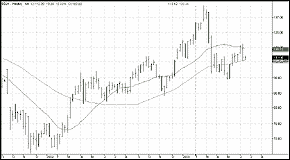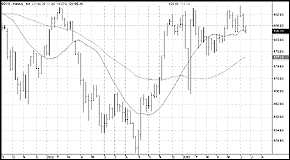Goldman Sachs Commodities Index
The Goldman Sachs Commodities Index (GSCI) is a world production-weightedindex
of commodity prices based on the average quantity of production for the
last five years of available data. In addition to being a benchmark against
which commodity price performance can be judged, the subgroups of the GSCI
are equally reliable measures of the price performance of the various commodities
that make up the GSCI. The provided weekly charts of these subgroups include
both the 20- and 50-period moving averages.
GSCI SUBGROUP: AGRICULTURE ($GKX)

The GSCI agriculture subgroup includes not only those commodities typically referred to as "the grains," but also many commodities generally included in the "softs" category. The subgroup's components include: wheat, red wheat, corn, soybeans, cotton, sugar, coffee, cocoa, and orange juice.
$GKX rallied in the spring and summer of 2002, breaking out above its 20- and 50-period moving averages late in the second quarter. The subgroup rallied sharply over the third quarter of 2002, peaking early in the autumn. Since that time, the agricultural subgroup has trended downward, finding support within its 20- and 50-period moving averages in the first half of 2003. Bear markets in both wheat and corn have played a significant role in the declines of the $GKX in 2003.
What they say: "Another factor that could buoy prices is the large bet that speculators on New York's Coffee, Sugar, & Cocoa Exchange have made against rising [coffee] prices. Commodity funds hold nearly 22,500 futures contracts to sell the underlying commodity. If prices go up, they'd have big losses. And prices are rising." -- Mara Lemos, "Percolating Up," Commodities Corner, Barron's: April 14, 2003.
ENERGIES ($GJX)

The GSCI energies subgroup includes crude oil, Brent crude oil, unleaded gasoline, heating oil, and natural gas.
$GJX broke out above its 20- and 50-period moving averages in the second quarter of 2002, but it was not until the first quarter of 2003 that the energies subgroup appeared capable of leading the moving averages higher. The energies subgroup corrected late in the first quarter of 2003, but appeared to find support on its 50-period moving average in the second quarter. Stubbornly high crude oil prices in the wake of the war with Iraq and continued fears of a shortage of natural gas have buoyed the $GJX in 2003.
What they say: "In summary, the long-term equilibrium price for natural gas in the United States has risen persistently during the past six years from approximately $2 per million Btu to more than $4.50. The perceived tightening of long-term, demand-supply balances is beginning to price some industrial demand out of the market. It is not clear whether these losses are temporary, pending a fall in price, or permanent." --Alan Greenspan, Federal Reserve Board chairman, in testimony before the US House of Representatives Committee on Energy and Commerce: June 10, 2003.
PRECIOUS METALS ($GPX)

The GSCI precious metals subgroup includes both gold and silver.
$GPX moved decisively above its 20- and 50-period moving averages early in the first quarter of 2002 and continued to advance strongly until the first quarter of 2003. A correction in the precious metals subgroup late in the first quarter of 2003 brought $GPX down briefly below its 50-period moving average, but as the second quarter of 2003 began, $GPX was again headed higher. The resilience of the gold price -- after years of persistent declines -- has been the major factor driving the $GPX higher in recent years.
What they say: "If we have a run on the dollar, there will be a panic to switch dollars to some other form of money. You have the euro, the yen, and gold. The euro and the yen are just another form of central bank paper. My feeling is that in the face of a swooning dollar, a huge amount of money will rush to the safety of real money -- gold." --Richard Russell, "…One ounce of gold," Dow Theory Letters: June 14, 2003.
LIVESTOCK ($GVX)

The GSCI livestock subgroup includes both live and feeder cattle, as well as lean hogs.
$GVX declined from a peak in the first quarter of 2002 to mark a bottom late in the third quarter of that year. Rallying from this intermediate-term bottom, the livestock subgroup moved back to the highs of 2002 by the fourth quarter and, save for a short, sharp correction early in the first quarter of 2003, $GVX has remained in the upper reaches of its trading range for the past three quarters.
What they say: "Beef demand reflects consumer sentiment, with optimism about the economic outlook translating into more sales of higher-cost cuts of meat. And cattle are subject to the same economics as other commodities, with periods of low prices causing suppliers to cut back until demand ignites prices again." --Jim Cote, "Let them eat steak," Commodities Corner, Barron's: March 17, 2003.
TradeStation (TradeStation Technologies)
Originally published in the August 2003 issue of Technical Analysis of STOCKS & COMMODITIES magazine. All rights reserved. © Copyright 2003, Technical Analysis, Inc.
Return to August 2003 Contents